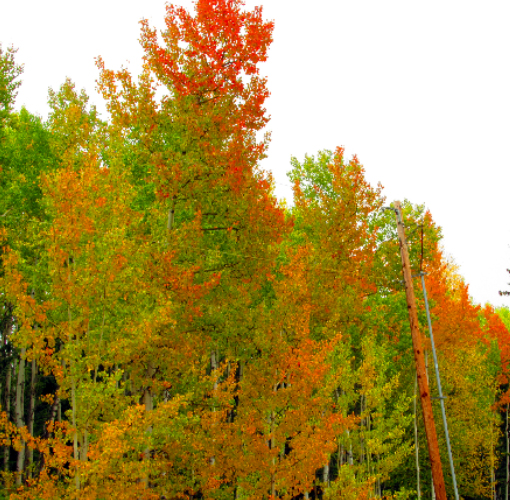Falling into autumn: Pretty reds can mean pretty dry and warm

Birch and aspen trees around Fairbanks are crowned with red leaves instead of the yellow and orange hues normally seen in the autumn.
Jessie Young-Robertson
Sept. 20, 2022
Have you noticed more red leaves this autumn compared to the past few years? I have lived here since 2008, and I have never seen so much red in our aspen and birch leaves.
I’m a boreal forest ecologist in the Institute of Agriculture, Natural Resources and Extension at UAF, and I study tree physiology. In the fall, I keep an eye on when the leaves change colors as well as the colors that show up.
Why are there more red leaves this year? It has to do with what the leaf pigments or colors do. First, they absorb light in the visible part of the spectrum.
Chlorophyll makes plants appear green. Chlorophyll is used in photosynthesis, the process of plants using light, carbon dioxide, and water to make oxygen and sugars for growth and reproduction. Chlorophyll is “expensive” for a plant because it “costs” a lot of nitrogen. At the end of the summer, nitrogen is reabsorbed by the plant as the chlorophyll breaks down.
The yellow and orange colors are called carotenoids which is what we see in the autumn.
During summer, carotenoids and chlorophyll are present in the leaf at the same time, but we can only see the green chlorophyll. In the autumn, when the chlorophyll breaks down, the carotenoids’ yellows and oranges are revealed. Most of our forest in Fairbanks appears yellow in the fall.
The combination of chlorophyll and carotenoids makes plants more efficient at capturing a wide range of the light spectrum for photosynthesis. Carotenoids also help the plant shed excess energy to reduce the damage too much sun can cause to leaves.
The red colors are called anthocyanins. Unlike carotenoids, anthocyanins are not present
throughout the summer. They are produced in the late summer under a certain set of
conditions (we’ll get back to this in a minute). Anthocyanins form a pigment layer
that acts as a screen to protect the leaf from sun
damage as the plant moves nutrients from the leaves into the stem when chlorophyll
breaks down in mid to late August. Studies have found that plants that turn red versus
yellow have better protection from high light stress.
What affects the colors we see in autumn? There are species differences. Dwarf birch and the leaves of blueberry plants tend to turn red and/or purple every year. However, aspen and birch tend to turn yellow in Interior Alaska, unless they are affected by the August weather.
In general, plants change color in response to decreasing sunlight. Typically, in
August, we have a lot of cloudy days and low sunlight, triggering the plants to start
their change. We also have days that are getting shorter, which cues plants for change.
The extent of red color and how long leaves show colors
depends on temperature and moisture in late summer. More reds are produced when days
are warm, sunny, and dry, with cooler nights. These conditions lead to a lot of sugar
production in the leaves, which contribute to making the red pigments. Cooler nights
narrow the leaf veins and trap sugars in the leaves.
This year in Fairbanks, there are more reds present than in the prior 12 years. Air
temperature this August has been warm compared to most years, but it is similar to
August 2020 when there were not as many red trees. There has been more sunlight reaching
the trees this year compared to most years, but
again, this is similar to 2020.
The big difference this year is the amount of rain. Rainfall from May through August
was significantly lower than in the past five years: about 3.5 inches this year compared
to 8 inches in 2020 (7.3 in 2021, 9 in 2019, 6.9 in 2018). It is likely that the combination
of low rainfall, warm temperatures, and more
sunlight reaching the trees (due to fewer cloudy days from not raining much) has contributed
to more reds this autumn.
Keep an eye out for red aspen and birch when August is dry and warm!
Jessie Young-Robertson is a boreal forest ecologist at University of Alaska Fairbanks’ Institute of Agriculture, Natural Resources and Extension.


